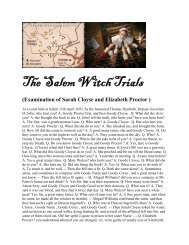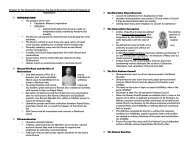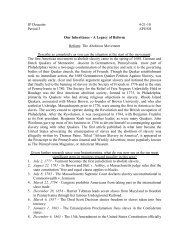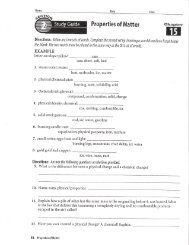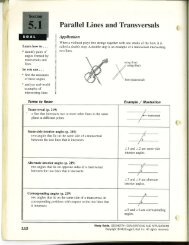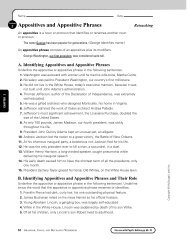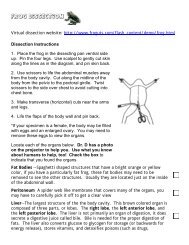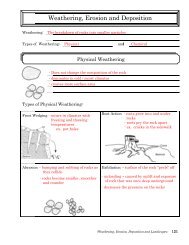Mexican Texans German Texans - Teacher
Mexican Texans German Texans - Teacher
Mexican Texans German Texans - Teacher
Create successful ePaper yourself
Turn your PDF publications into a flip-book with our unique Google optimized e-Paper software.
Texas: Where the World Meets<br />
The new state of Texas became home for immigrants from many countries. Immigrant groups have journeyed to Texas<br />
throughout history for a variety of reasons, bringing with them unique customs and traditions. Many Texas towns and cities<br />
were founded by immigrants.<br />
<strong>Mexican</strong> <strong>Texans</strong><br />
The census of 1850 did not measure the number of <strong>Mexican</strong> <strong>Texans</strong> in the state. However, historians<br />
suggest that there may have been 23,000 Tejanos. Most <strong>Mexican</strong> <strong>Texans</strong> lived in or near San Antonio,<br />
between the Nueces River and the Rio Grande, or along the Rio Grande from west of Big Bend to El<br />
Paso. Some Tejanos, such as José Antonio Navarro, owned successful cattle or sheep ranches or<br />
businesses. Others worked as sheepherders, cowhands, or ranch laborers.<br />
<strong>German</strong> <strong>Texans</strong><br />
During the 1840s and 1850s Texas also attracted immigrants from Europe. By 1860 more than 43,000<br />
people born outside of the United States lived in Texas. <strong>German</strong>s made up the largest number of these
settlers. Although some <strong>German</strong>s came to Texas seeking political or religious freedom, others arrived<br />
in search of economic opportunities. <strong>German</strong>s settled in New Braunfels and other communities to the<br />
north and west, including Fredericksburg.<br />
Other Immigrants from Europe<br />
The Irish and English were the second and third largest groups of Europeans to settle in Texas. In 1845<br />
many Irish fled their homeland because a disease attacked Ireland’s main food crop, the potato,<br />
causing a famine. By 1850 there were 1,403 Irish settlers in Texas. The number increased to 3,480 by<br />
1860. Many Irish immigrants settled around San Patricio and Refugio.<br />
Texas settlers came from almost every nation in Europe. Polish immigrants led by Father Leopold<br />
Moczygemba (moh•chee•GHEM•bah) settled in the town of Panna Maria in Karnes County. Ernst<br />
Bergman and Josef Lesikar led a large group of Czechs into Central Texas. Immigrants from Sweden,<br />
Norway, Italy, and the Netherlands also arrived in large numbers during the 1850s.<br />
Native <strong>Texans</strong><br />
President Lamar had forced most Native <strong>Texans</strong> out of East Texas during the years of the Republic.<br />
His policy was called the removal of the Native <strong>Texans</strong>. However, many Comanches and Kiowas still<br />
lived in the western part of the state. The growing population of Texas spread even farther west onto<br />
Native <strong>Texans</strong>’ hunting land. This loss of land increased tensions with native groups.<br />
Migration from the United States<br />
Most of the new <strong>Texans</strong> emigrated from the United States, mostly from the South. During the 1850s<br />
many immigrants came from Arkansas, Louisiana, Tennessee, and Alabama. These settlers generally<br />
moved directly to the frontier line. There they could farm as they had at their previous homes.<br />
Immigrants from Georgia and Mississippi usually settled in the pine belt of East Texas and cleared<br />
land for cotton crops. Louisianians settled mainly in the lower regions of rivers near the coast, where<br />
they grew sugar cane. People tended to settle in areas that were similar to their former homes.<br />
Slavery had existed in Texas for many years. African American slaves were brought to Texas by their<br />
owners during the colonial period despite some efforts by the <strong>Mexican</strong> government to free them. By<br />
1860 the slave population was growing faster than the free population. Even though most white people<br />
in Texas did not own slaves, they generally supported slavery. They claimed that slavery was needed<br />
to support the economy of the South. However, many groups in Texas, including <strong>German</strong> immigrants<br />
and Tejanos, opposed slavery. They argued that it was morally wrong for one person to own another<br />
person.<br />
Source: McDougal Littell, Celebrating Texas
Directions: Use the map, the reading passages, and your textbook to complete the following<br />
activities.<br />
Part I: On the world map, label the following European countries and then color each a different color: <strong>German</strong>y,<br />
Ireland, Czechoslovakia; and label Mexico. Using a ruler, draw a line from that country to the approximate<br />
region of Texas where they settled. Use the color of the country for the line.<br />
www.factmonster.com<br />
Part II: On the following map of Texas, label where the immigrant group settled; label modern day cities in these<br />
locations as described in the readings.
Part III: Use the passage and the maps to complete the following organizer.<br />
Immigrant Group Where they settled? Why they came to Texas?<br />
How do you think they<br />
impacted Texas culture?<br />
<strong>Mexican</strong> <strong>Texans</strong><br />
<strong>German</strong> <strong>Texans</strong><br />
Irish<br />
Polish<br />
Settlers from the<br />
American South<br />
African<br />
Americans<br />
Czechs



